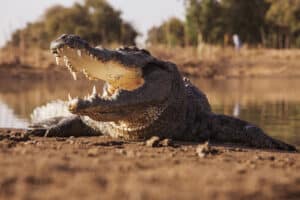Crocodiles are widespread reptiles that have a unique combination of speed, power, and stealth that make them incredibly deadly apex predators in places they live. These creatures can survive in freshwater or saltwater, so their range throughout the world is extensive. However, there are several different species of crocodiles. Today, we’re going to examine the American crocodile vs. the Nile crocodile and show you what sets them apart. By the time we’re finished, you’ll know several differences between these species!
Comparing an American Crocodile and a Nile Crocodile
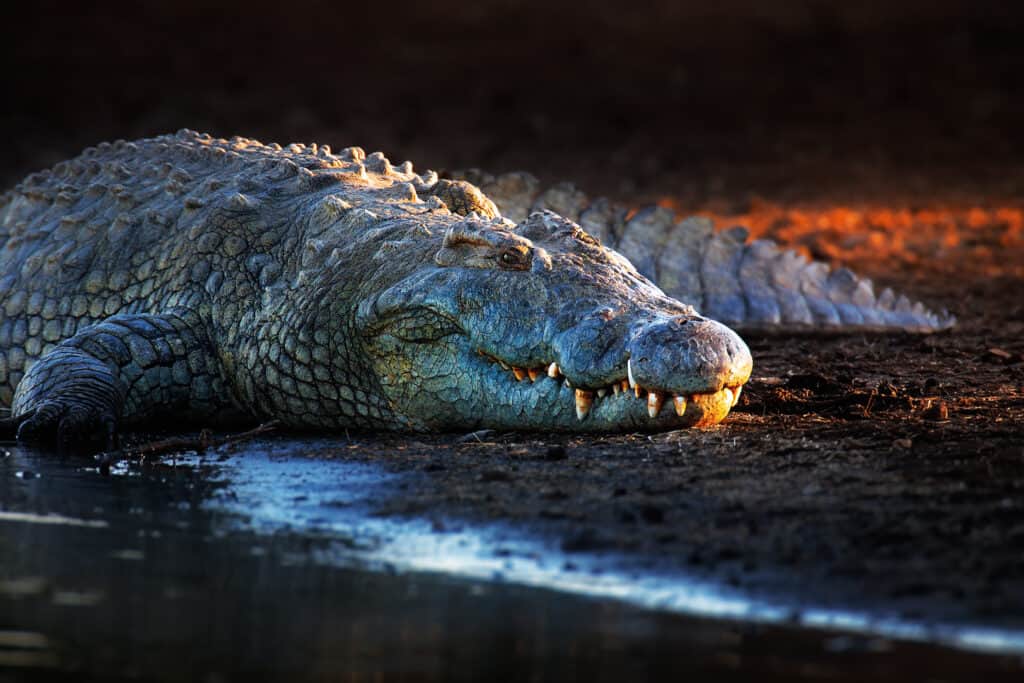
The Nile crocodile averages 9 to 15 feet in length and weighs between 500 and 910 pounds.
©Johan Swanepoel/Shutterstock.com
| American Crocodile | Nile Crocodile | |
|---|---|---|
| Size | Weight: 500-800 lbs, up to 2000 lbs Length: 9-13 feet, up to 20 feet at their longest | Weight: 500-910 lbs, up to 2,400 lbs Length: 9-15 feet, up to 21 feet |
| Species | Crocodylus acutus | Crocodylus niloticus |
| Morphology | – Quadrupedal – Has a long and strong tail – Scaly body – Grayish-green scaly hide with a yellowish or cream underside – Often has spots on its sides – Possesses scutes running down the length of its back | – Quadrupedal – Bronze color on top of its body with yellowish-brown on its sides – Cream-colored underside with spotted sides – Has scutes running down its body |
| Location | – Prefers saltwater or brackish areas – Often found in mangrove swamps, creeks, and waters with more saltwater – Southern Florida in the U.S. – Central America, western and southeastern coasts of Mexico, Cuba, Dominican Republic, Haiti – Columbia, Venezuela, and Ecuador in South America | – Can tolerate saltwater, but it’s usually found in freshwater rivers – Found throughout sub-Saharan Africa, including Madagascar – Prefers rivers, streams, tidal lakes, estuaries, |
| Prey | – Apex predator – Consumes various prey in different locations – Herons, pelicans, opossums, raccoons, snakes, sea turtles, and even lemon sharks | – Apex predator in its area – Birds, zebras, wildebeests, frogs, waterfowl, and much more – Capable of eating just about anything in its range, including people |
| Relationship with Humans | – Avid hunter, but very shy around human beings – Attacks and fatalities are rare | – Considered to be far more aggressive than the American crocodile toward humans – Responsible for about 1,000 human deaths every year |
The 5 Key Differences Between an American Crocodile vs. Nile Crocodile
The greatest differences between an American crocodile and a Nile crocodile are their size, colors, and location. The American crocodile grows to an average length of between 9 and 13 feet and weighs up to 800 pounds, and the Nile crocodile averages 9 to 15 feet in length and weighs between 500 and 910 pounds on average.
The Nile crocodile has a bronze-green coloration on the top, a yellowish-brown on the sides, and a cream-colored underside. Still, the American crocodile is grayish-green on top with a yellowish or cream underside. Both species have spots on their sides, too.
As their names suggest, the American crocodile lives in the Americas, including North America, Central America, and South America. Meanwhile, the Nile crocodile lives in Sub-Saharan Africa except for the southernmost reaches of the continent, although the species may also have a foothold in the United States.
American Crocodile vs. Nile Crocodile: Size
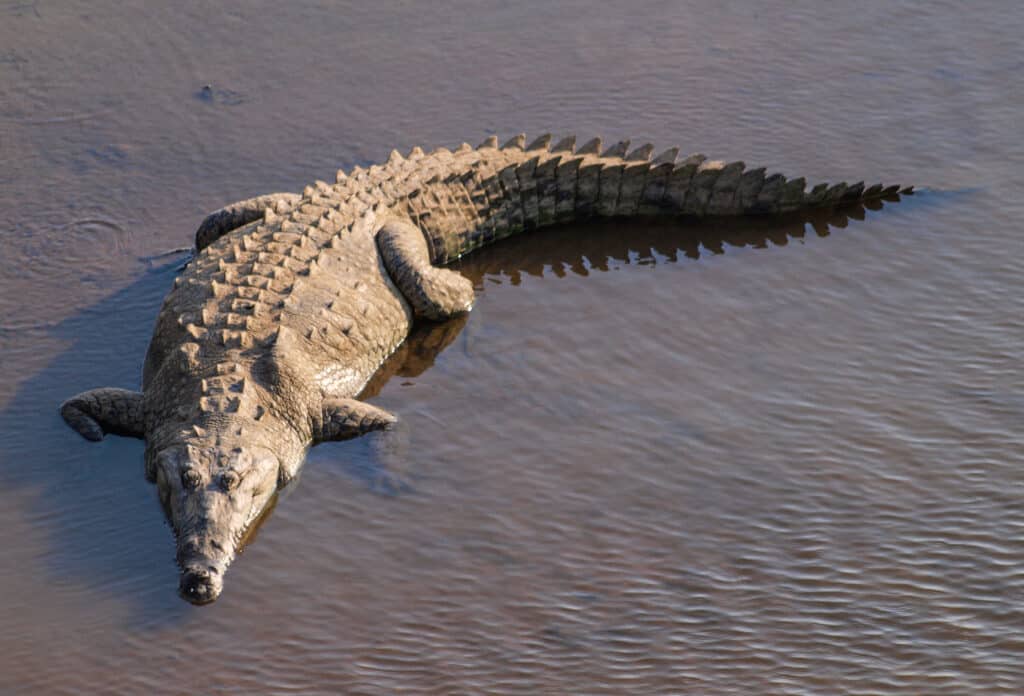
The average American crocodile weighs between 500 and 800 pounds, but the largest ones weigh upwards of 2,000 pounds.
©iStock.com/CStorz
On average, the Nile crocodile is larger than the American crocodile and at its greatest size. On average, the Nile crocodile grows up to 910 pounds, but the largest ever recorded weighed over 2,400 lbs. Furthermore, although they grow upwards of 9-15 feet on average, the longest Nile crocodile measured 21 feet long!
The average American crocodile weighs between 500 and 800 pounds, but the largest ones weigh upwards of 2,000 pounds. Also, the American species grows up to 13 feet at the high end of its average size and 20 feet at its maximum. These are massive creatures! Both species of crocodiles are larger than any species of alligators, though.
American Crocodile vs. Nile Crocodile: Species

The Nile crocodile has a bronze color on its body that evolves into a muddy yellowish-brown on its sides.
©David Havel/Shutterstock.com
Nile crocodiles and American crocodiles are different species. Although the two creatures look alike, they are not the same species. The American crocodile is Crocodylus acutus, and the Nile crocodile is Crocodylus niloticus.
American Crocodile vs. Nile Crocodile: Morphology
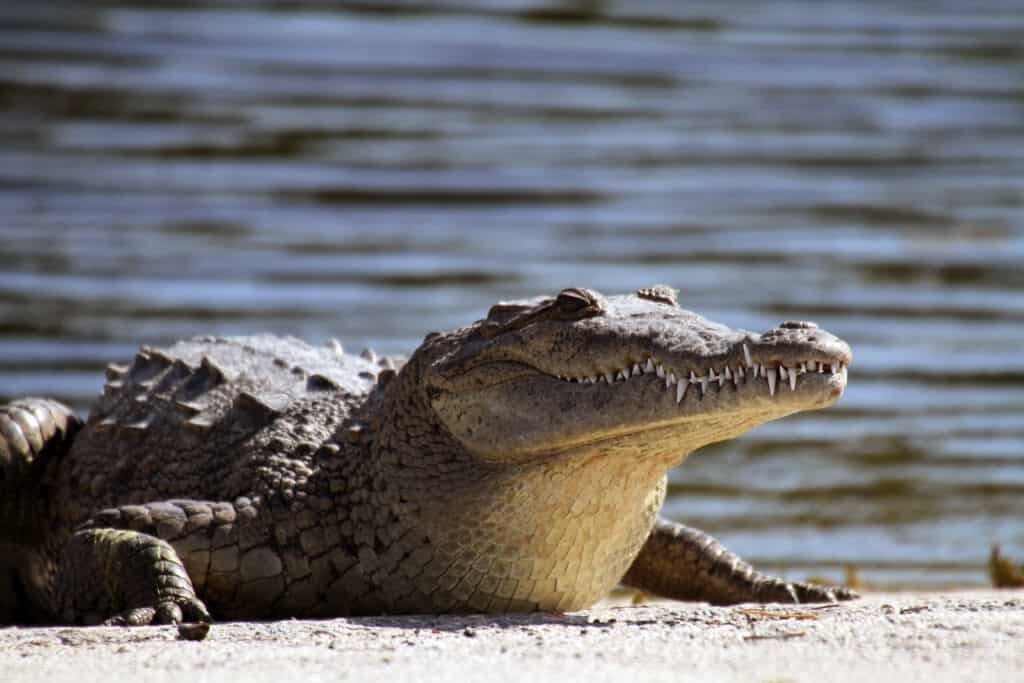
The American crocodile is often grayish-green on its back, has spotted sides, and has a yellowish or cream-colored underside.
©iStock.com/GriffinGillespie
Nile crocodiles and American crocodiles are similar looking, but they do have some differences. At first glance, it can be hard to tell an American crocodile from a Nile crocodile unless you look at their size. However, color is the best way to differentiate these creatures at the same size.
The American crocodile is often grayish-green on its back, has spotted sides, and has a yellowish or cream-colored underside. The Nile crocodile has a bronze color on its body that evolves into a muddy yellowish-brown on its sides and turns into a cream-colored underside.
Since these creatures often wallow in muddy areas, it can be hard to see their colors. Other than their color and size, these animals are remarkably similar.
American Crocodile vs. Nile Crocodile: Location
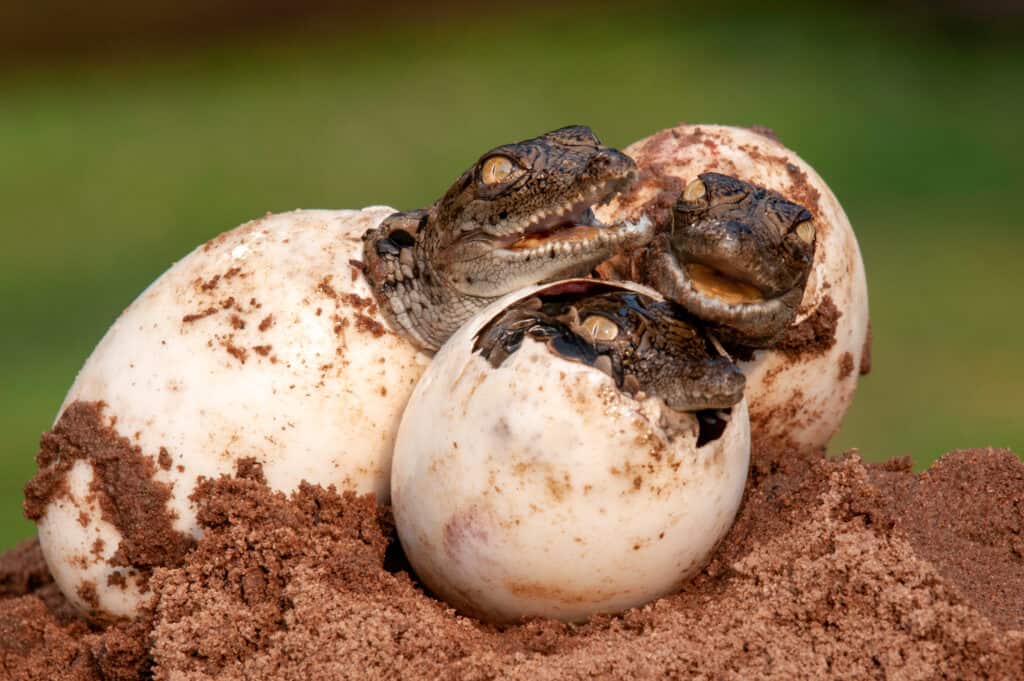
The Nile crocodile has a large range, spreading throughout most of Africa below the Sahara Desert.
©Catchlight Lens/Shutterstock.com
Nile crocodiles prefer staying in freshwater rivers and lakes, but they can also be found in some brackish waters. They are rarely found in saltwater. However, American crocodiles frequently live in brackish and saltwater areas along coasts and within coves.
The American crocodile is found in the Americas, and the Nile crocodile is found in sub-Saharan Africa. You can find American crocodiles in the southernmost areas of Florida in the U.S., throughout several countries in the Caribbean Sea, on the west and southeastern coasts of Mexico, and into the northern part of South America.
The Nile crocodile has an even larger range, spreading throughout most of Africa below the Sahara Desert. They have even made their way to Madagascar, but they are not as common in the southernmost areas of Africa. However, reports of Nile crocodiles making their way to the Americas are becoming more frequent, especially in the Florida Everglades.
American Crocodile vs. Nile Crocodile: Prey
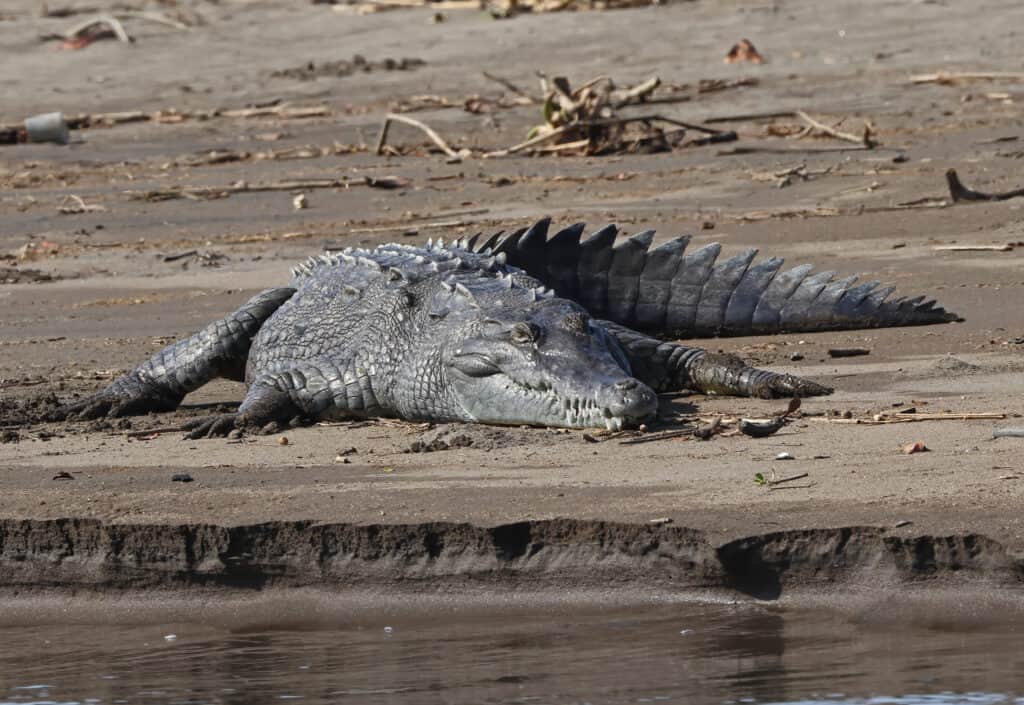
American crocodiles often eat waterfowl, mammals, snakes, sea turtles, and the occasional lemon shark.
©iStock.com/neil bowman
Both American crocodiles and Nile crocodiles are apex predators in their respective ranges. They can eat just about anything they can grab. Yet, their different locations throughout the world give them access to different prey.
American crocodiles often eat waterfowl, mammals, snakes, sea turtles, and the occasional lemon shark. Nile crocodiles eat birds, zebras, waterfowl, frogs, wildebeests, and even human beings.
American Crocodile vs. Nile Crocodile: Human Relationships

Nile crocodiles kill roughly 1,000 people per year throughout their range.
©Mari Swanepoel/Shutterstock.com
American crocodiles are known to be very shy creatures that would sooner flee from a person than kill them. Relatively few attacks have been recorded in the Americas, and only a handful have been fatal.
However, Nile crocodiles kill roughly 1,000 people per year throughout their range. They have no fear of people and may regard us as just another sort of prey. Crocodiles have serious impacts on human life in terms of attacks on people and livestock in Africa.
All in all, the American crocodile and the Nile crocodile are similar creatures with a handful of differences. As the two species start to come into closer contact with one another, the small differences between their species may start to blur.
Up Next:
- Discover the Largest Crocodile Attack in Human History (500+ Died)
- Alligator vs. Crocodile: 6 Key Differences and Who Wins in a Fight
- Crocodile vs Shark: Who Would Win in a Fight?
- Anaconda vs Crocodile: Who Would Win in a Fight?
- Lion vs Crocodile: Who Would Win in a Fight?
- Hippo vs Crocodile: Who Would Win in a Fight?
The photo featured at the top of this post is ©
Sources
- Ingenta, Available here: https://www.ingentaconnect.com/content/whp/eh/2016/00000022/00000003/art00006
- ECOS, Available here: https://ecos.fws.gov/ecp/species/1933
- U.S. Department of the Interior, Available here: https://nas.er.usgs.gov/queries/factsheet.aspx?SpeciesID=223
- University of Florida, Available here: https://crocdoc.ifas.ufl.edu/publications/factsheets/crocodileindicator.pdf
- Florida Fish and Wildlife Conservation Commission, Available here: https://myfwc.com/wildlifehabitats/profiles/reptiles/american-crocodile/
Thank you for reading! Have some feedback for us? Contact the AZ Animals editorial team.





